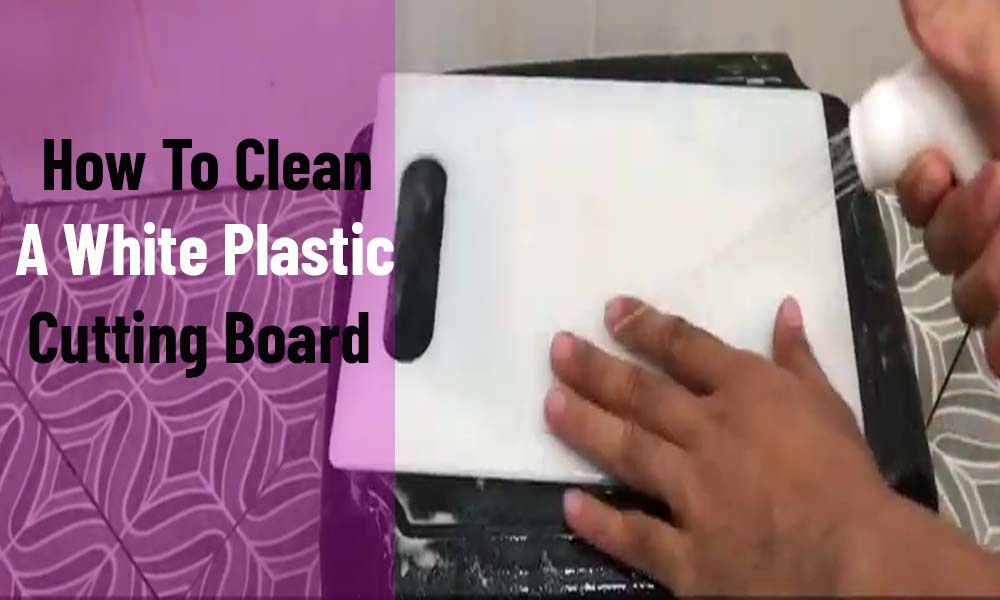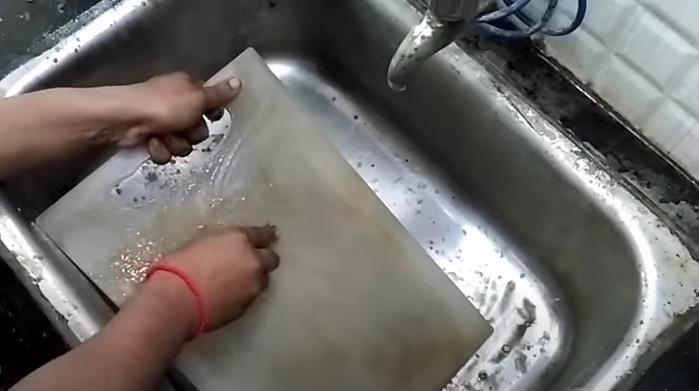How To Clean A White Plastic Cutting Board? 2023’s Best Ways

A white plastic cutting board is a staple in most kitchens, used for everything from chopping vegetables to slicing meat. But constant use leads to wear and tear, which causes stains and smells that aren’t very nice. Because of this, it’s important to know how to clean a white plastic cutting board. If you don’t clean your cutting board well, harmful bacteria can grow on it, so it’s important to keep it clean and sanitized.

In this detailed guide, I’ll show you tried-and-true ways to keep your white plastic cutting board in great shape, both from an aesthetic and a health point of view. Say goodbye to stains, smells, and bacteria, and hello to a clean and safe cutting surface for all your food preparation needs. So, let’s dive into the world of cleaning white plastic cutting boards and find out how it’s done.
How To Clean A White Plastic Cutting Board
Cleaning a white plastic cutting board is relatively easy, and you can do it using the following steps:
1. Prepare the materials needed:
For cleaning a white plastic cutting board, first, you need to gather all the materials needed, which include:
- cutting board
- mild dish soap
- clean dish cloth
- baking soda
- and white vinegar.
2. Create a cleaning solution of mild dish soap and warm water
To create a cleaning solution for a white plastic cutting board, mix together a few drops of mild dish soap with warm water.
3. Pre-rinse the cutting board with water
Pre-rinsing the cutting board is an important step in the cleaning process. This helps remove any loose debris, dirt, and food particles from the cutting board’s surface. Start by gently running warm water over the cutting board, and use a soft cloth to scrub away any remaining dirt. Make sure to rinse the board thoroughly to ensure all food particles are removed.
4. Scrub the cutting board with the cleaning solution using a dishcloth
After rinsing the cutting board with warm water, make a cleaning solution with a few drops of liquid soap and a cup of warm water. Dip a dishcloth into the cleaning solution and use it to scrub the cutting board in a circular motion. This will help to remove any stuck-on debris and grease.
5. Rinse the cutting board and dry it with a clean dishcloth
Rinse the cutting board with warm water and use a clean dishcloth to dry it. Make sure that all the soap residue is removed from the board. Also, rinse the cloth with warm water and let it dry completely. This will help to keep the board clean and free from any bacteria.
That’s it of how to clean a white plastic cutting board. With these steps, you can keep your white plastic cutting board clean and hygienic for your next food preparation.
How Do I Keep My Cutting Board Clean?

Keeping your cutting board clean is important so that harmful bacteria that can cause food-borne illnesses don’t grow on it. Here are some ways to keep your cutting board clean:
- When you use your cutting board, wash it with hot soapy water. Scrub the surface well with a scrub brush or sponge. Use hot water to rinse and a clean towel to dry.
- Use a solution of 1 tablespoon of unscented liquid chlorine bleach per gallon of water to clean your cutting board. Apply the solution to the board and let it sit for a few minutes. Then, rinse it with hot water and dry it with a clean towel.
- To avoid mixing raw meat, poultry, and seafood, use different cutting boards for each.
- If your cutting board is very worn or has deep grooves that are hard to clean, you should get a new one.
- Don’t use harsh cleaners or steel wool on your cutting board because they can damage the surface and make cleaning harder.
- Keep your cutting board somewhere dry, away from water and humidity.
Using these tips, you can keep your kitchen cutting board clean and safe.
How Often To Clean Cutting Boards?

Cutting boards should be cleaned after each use so that bacteria and other harmful pathogens don’t spread from one board to another. However, how often you need to clean your cutting board depends on how often you use it, what you cut on it, and how you store it.
If you cut raw meat, poultry, or fish on your cutting board every day, you should wash and sanitize it after each use. This makes it harder for bacteria and other harmful pathogens that can make you sick to eat to grow.
If you only use your cutting board to cut fruits and vegetables or use it less often, you may not have to clean it as often. But you should still wash it with hot, soapy water after every use and store it in a clean, dry place. Ultimately, it’s best to err on caution and clean your cutting board often to avoid getting sick from food.
FAQ:
1. Is using bleach to clean a plastic cutting board safe?
Yes, using bleach to clean a plastic cutting board is safe. It is best to use a mixture of 1 teaspoon of bleach per quart of water. Rinse the board thoroughly with water after using the bleach mixture.
2. How often should a plastic cutting board be sanitized?
Plastic cutting boards should be sanitized after every use or at least once a day.
3. How can one prevent plastic cutting boards from staining?
One can prevent plastic cutting boards from staining by cleaning them with mild detergent and warm water after every use, avoiding leaving them in standing water, and regularly sanitizing them.
4. Is using vinegar while cleaning a plastic cutting board beneficial?
Yes, using vinegar while cleaning a plastic cutting board is beneficial. Vinegar is a natural disinfectant that can help remove bacteria from the board. It also helps remove tough stains and odors that can build up on the board. Additionally, vinegar is mild and won’t damage or discolor the plastic surface of the board.
Final Thought
Home cooks or chefs must know how to clean a white plastic cutting board. By doing the easy steps above, you can ensure that your cutting board stays clean and bacteria-free. Cleaning your cutting board often with soap and water and disinfecting it every so often with a bleach solution or vinegar can help stop cross-contamination and make your cutting board last longer.
Always cut raw meats and poultry on a separate cutting board and get a new one if it gets worn or has deep grooves or cracks. Taking care of your white plastic cutting board can make your kitchen a safe and clean place to prepare food and feel good about eating tasty, healthy meals. So go ahead and start cutting, but make sure your cutting board is clean and shiny.
More Read:





